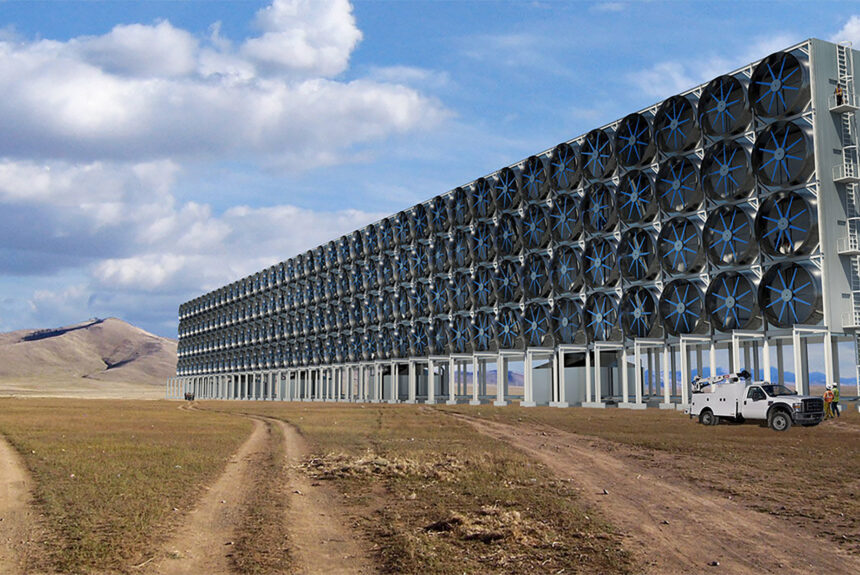In a bid to scale up investment in promising carbon dioxide (CO2) removal technologies, the Department of Energy (DOE) has allocated $1.2 million towards America’s nascent but rapidly growing carbon dioxide removal (CDR) industry. In an announcement on May 28, DOE selected 24 semifinalists for its historic Carbon Dioxide Removal Purchase Pilot Prize.
Funded by the Bipartisan Infrastructure Law, the prize incentivizes the development and deployment of innovative CDR solutions by offering competitive awards to participants who successfully demonstrate the ability to remove CO2 from the atmosphere at a large scale.
>>>READ: What’s the Future of Direct Air Capture?
The prize works like this: Companies compete for the opportunity to supply CDR credits directly to DOE. These credits are then made available for purchase by any individual or entity interested in purchasing CO2 offsets, with DOE facilitating the purchase and distribution in the broader carbon market.
The initiative is part of DOE’s Carbon Negative Shot, an ambitious public-private initiative to lower the cost of carbon dioxide removal to less than $100 per net metric ton, down from the current price range of $250-$600 per metric ton. In addition to funding innovative technologies, the Carbon Negative Shot also aims to establish robust monitoring, reporting, and verification (MRV) techniques to quantify the impact of CDR. Establishing reliable MRV will reduce corruption and increase investor confidence in the nascent industry.
While the Pilot Prize offers up to $35 million in total cash awards through Carbon Dioxide Removal Credit Purchase Agreements from DOE, the current round’s 24 semifinalists will each receive $50,000, totaling $1.2 million. This funding will support the scaling of diverse CDR approaches across four pathways:
- Direct air capture with storage: Also referred to as ‘DAC+S,’ DOE is funding nine projects that directly capture CO2 from the atmosphere. This captured carbon is subsequently stored underground in deep geological formations or converted into a variety of valuable products such as feedstock for chemical processes or renewable fuels.
- Biomass with carbon removal and storage: Seven projects employ plants and algae to extract CO2 from the air, storing it permanently underground or incorporating it into durable goods like biofuels or renewable natural gas.
- Enhanced rock weathering and mineralization: Five projects sequester CO2 by reacting it with alkaline substances like crushed rocks abundant in calcium or magnesium.
- Planned or managed carbon sinks: Three projects are developing ways to absorb CO2 from the atmosphere and store it in long-lasting and secure reservoirs. A carbon sink is any natural or man-made reservoir that absorbs more carbon than it releases.
Some of the semifinalists from Phase 1 include Swiss DAC technology provider Climeworks, which is working alongside Battelle and Heirloom to develop one of the nation’s first DAC+S hubs. In late March, DOE awarded Climeworks $50 million in funding from the DOE’s Office of Clean Energy Demonstrations (OCED) to kickstart its Project Cypress DAC Hub in Southwest Louisiana. Project Cypress builds on the company’s Mammoth plant in Iceland, the world’s largest DAC plus storage facility. Climeworks has agreed to provide 3,500 CDR credits to DOE over the prize period.
In the biomass field, Bill Gates-backed startup Graphyte will contribute 30,000 CDR credits to DOE with its innovative carbon casting technology. According to the CEO and founder of Graphyte, Barclay Rogers, carbon casting is a nature-based solution that leverages engineering techniques to store CO2 safely and affordably. The emerging technology leverages the inherent carbon-absorbing abilities of plants and trees, utilizing a reverse-engineered approach to photosynthesis to halt decomposition. Graphyte uses low-value biomass like wood byproducts from the timber industry or crop residue from farming and agriculture operations to start the process.
>>>READ: Three ARPA-E Startups that are Accelerating Energy Innovation
Mati Carbon of Houston will leverage enhanced rock weathering to improve U.S. rice productivity. Enhanced weathering, also known as carbon mineralization, expedites the natural phenomenon where minerals within rocks interact with atmospheric CO2, effectively sequestering carbon while supporting overall soil health. The CDR technique benefits agriculture by increasing the amount of available nutrients in the soil, regulating soil pH, improving soil structure, and locking away carbon. Mati Carbon will supply 4,561 credits to DOE.
California startups Ebb Carbon and Equatic are among the winners in the planned or managed carbon sink pathway. Each will deliver 3,000 and 6,521 CDR credits to DOE, respectively.
Using seawater and low-carbon electricity, Ebb Carbon taps into the world’s largest carbon sink –– the ocean –– to accelerate the natural process of ocean alkalization. Ocean alkalization is the million-year old process by which the Earth regulates the pH levels of the ocean and sucks CO2 from the air. Ebb’s ocean-inspired alkalinity enhancement solution, which captures carbon dioxide as bicarbonate, contributes to ocean deacidification and permanent CO2 storage.
Equatic similarly harnesses the power of the seas to remove gigatons of CO2 at scale via seawater electrolysis. Seawater electrolysis pairs carbon dioxide removal with the generation of green hydrogen, a truly sustainable fuel produced by using renewable energy to split water molecules.
The Carbon Dioxide Removal Purchase Pilot Prize aims to stimulate investment and innovation in up-and-coming carbon removal technologies while providing a mechanism for companies to monetize their carbon removal efforts and contribute to mitigating climate change. As greenhouse gas emissions continue to drive climate change, strategies that actively encourage private sector investment and collaboration in high-quality CDR markets will be essential to securing a cleaner and more sustainable future.
Nathalie Voit is a freelance content creator and a graduate of the University of Florida. She is an alumni of The Heritage Foundation’s Young Leaders Program.
The views and opinions expressed are those of the author’s and do not necessarily reflect the official policy or position of C3.
